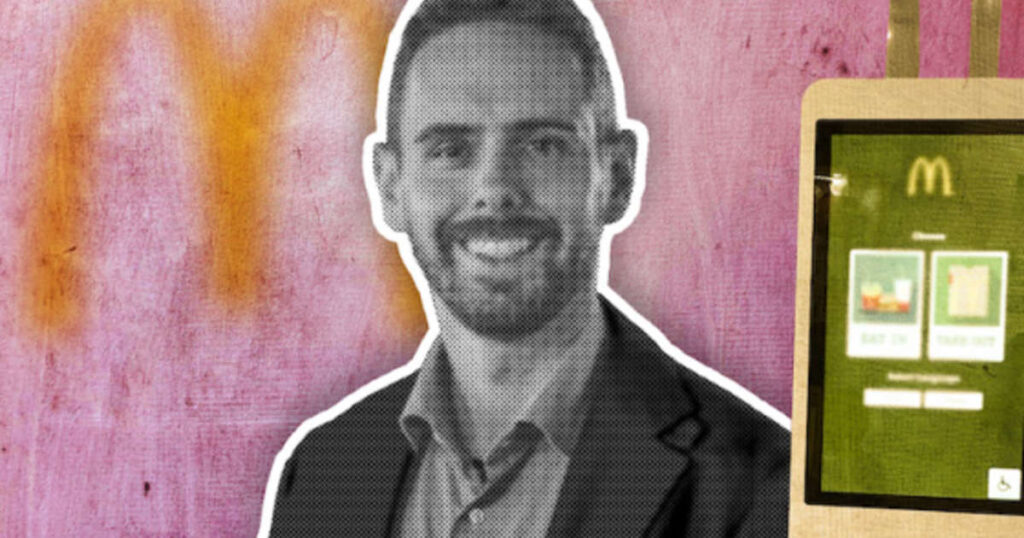a View From a Franchisee


Industries must adapt and innovate to stay competitive in an ever-evolving digital landscape. The food service sector is no exception. We sat down with Aris Gysel, a key figure in McDonald’s Switzerland, to discuss his experience steering the digital transformation of McDonald’s restaurants. In this interview, Aris shares his insights on digital ordering systems, the challenges of implementation, and the impact on customer experience and staff roles.
One caution I would share is that with the evolution of digital technology, the need to invest in hardware and IT systems has greatly increased. The lifespan of equipment like screens, cash registers, self-ordering kiosks, and overall IT infrastructure is much shorter than when I started 20 years ago.ARIS GYSEL
Takeaways
Customer-Centric Focus: The shift to digital platforms has revolutionised customer experience, offering convenience and personalisation that drive engagement and loyalty.
Challenges and Solutions: Overcoming resistance to change and technical hurdles requires a collaborative effort and a willingness to innovate and adapt.
Impact on Staff Roles: Digital transformation has reshaped staff roles, emphasising direct customer interaction and enhancing service quality.
Franchise Collaboration: Successful digital transformation in a franchise model hinges on strong collaboration between franchisors and franchisees.
Investment in Technology: Ongoing investment in digital infrastructure is crucial as technological advancements evolve.
Can you describe the digital transformation journey at your McDonald’s restaurants in Switzerland, focusing on the shift towards self-service kiosks and digital ordering? How does this compare to the broader changes in McDonald’s globally, especially in countries like France and Germany?
We began shifting to digital services in 2016, and by 2019, it took off with the introduction of self-ordering kiosks. Initially, these kiosks were slow and disrupted our food service process. It wasn’t until we adapted our operations to include “made for you” and table service that the kiosks became efficient. Customers could order at their pace without waiting in line, improving their experience as the food was served directly to their tables. By the time COVID-19 arrived, half of our customers were using the kiosks. The pandemic greatly accelerated our digital shift; we even closed our cash registers, making kiosks the primary point of service. Today, 95% of my customers prefer using these self-ordering kiosks.
In 2019, we introduced our app in Switzerland mainly to share information. Later, we added deals our customers could use right from the app. In 2021, we made ordering and paying through the app and earning loyalty points possible. This was a big deal. Now, customers can place orders on the app and then drive through to pick up or sit at a table and get their food served. We’re still improving this service, and while customers are learning this new way to order, more people are starting to use it.
What were your main challenges in implementing self-service kiosks and digital solutions at an individual restaurant level? Could you walk us through overcoming these hurdles, from initial planning to execution and eventual operation?
The most difficult challenge for me and my team was seeing why this change was important for the future. It was something new, and no one else in our industry was doing it, so we had no examples to follow. Initially, there was a lot of resistance and doubt about the new changes. It took time to overcome these feelings, and in the end, we had to take a leap of faith. After we did, we started to see good results, which helped us trust we were doing the right thing.
We also had technical problems with our IT and equipment. We had to work together to find and resolve each issue. It was hard work and took some time, but we improved our equipment, software, and infrastructure. Being part of the global McDonald’s network helped a lot because different markets could learn from each other, and we didn’t have to keep solving the same issues from scratch.
The main issue in the restaurants was that we had to entirely change how we worked, right from the basics. This meant training the staff in every Swiss restaurant individually. As a franchise owner, I had to work hard to help my teams understand the new ways of working. I also had to relearn everything I knew for the past 15 years.
We’re facing another change: customers used to order from a set number of points, like the cashier, drive-thru, or self-order kiosks. Now, they carry the ordering point in their pocket with our app so that we can get lots of orders at once. This means we need to focus more on how much we can make and how fast we can do it.
How has the introduction of digital ordering systems affected your staff structure and their roles? There’s a notion that digital solutions might reduce the need for staff. Has that been the case, or have you noticed a shift in how staff contribute to service quality instead?
As mentioned, the whole process in our restaurants had to change. It’s strange to think that not long ago, guests would line up to order at the cash registers, get pre-prepared food from a holding area, pay, and then take their food. Now, guests can order at self-service kiosks and have their food freshly made and delivered to their table. We’ve kept updating and adding food delivery and app ordering.
For our restaurant teams, this means constant change and learning. Simple tasks have become more complex, some old roles have disappeared, and new ones have been created.
Staffing levels have stayed about the same, but the jobs have shifted. Fewer crew members are behind the counter, and more are out in the lobby providing service. The counter used to be a barrier between our crew and guests, but now we interact more directly with customers. This has helped us improve our service, as our customer ratings show. Each function is more specialised, allowing faster service and better quality.
The hotel industry’s franchise model is often seen as a barrier to digital innovation. How has McDonald’s, with a similar franchise structure, managed to navigate and implement these digital changes successfully? What lessons could the hotel industry learn from this?
The franchisor and the franchisees must work well together. While not always easy and by no means frictionless, McDonald’s and we, as franchisees, have managed to find a way together. It was also very important that McDonald’s took a bold stand, participated in the investment, and helped with good coaching and training for the new system.
We also worked closely within the franchisee structure. This means that if a franchisee started the transition to the new system, he or she would visit a franchisee organisation that had already undergone the change, and learnings and findings would be exchanged.
How has the shift to digital ordering, especially with self-service kiosks and mobile orders, transformed the customer experience in your restaurants? Have you noticed a significant change in customer behaviour or expectations since introducing these technologies?
The change in customer experience has been dramatic for our guests. It was also challenging for them to learn how to use new tools and understand the benefits of digitalisation. Especially in the beginning, there was notable concern that we would replace our workers with machines. Quite a few guests refused to use our self-ordering kiosks.
They had to be patient with us and forgive longer waiting times while we learned the new procedures. Especially at the start, it was difficult. We only had a few stores in Switzerland that upgraded to the new system. Sometimes, we had one store with the new system and just down the street, a store with the old system. This was a challenge for our guests because you had to order differently, have a different menu, and have a different experience depending on the store. We are one brand for the guest, and it was hard to understand why there would be a difference from store to store.
Once the guests got used to it, however, they thanked us with better reviews and more visits. The transition to the new system has kicked off a multi-year upward trend in sales and guest count for my stores. Also, the total comparable sales for Switzerland show a multi-year positive trend.
Today, it’s unthinkable to work without our digital systems. Ordering is so much more frictionless for our guests. Of course, with this comes the challenge of living up to the new standard. Fresher products delivered faster, on one of the many POS of choice at almost any time and every place.
Implementing digital platforms requires significant IT support and staff training. How did you manage the IT challenges and train your team to adapt to these new systems? Was there a specific approach that ensured a smooth transition for staff and customers?
On a national level, the IT department managed the main tasks while we were in the restaurants, providing feedback and testing new updates and solutions. This collaborative effort required significant energy from both sides to perfect the infrastructure, especially during the initial three years as issues gradually decreased. Even now, I believe it’s critical to continually monitor this area because adding new systems can introduce more potential problems.
Regarding training, we successfully implemented a model in which one store per franchisee provided training to other stores within the same franchise. This method proved very effective.
Can you discuss the investment required for this digital transformation, including adopting self-service kiosks and mobile ordering apps? How has this investment impacted your bottom line, and have you seen a return on this investment?
Upgrading my business to the new system was a significant investment, and McDonald’s also heavily invested in this change. Initially, I was uncertain if this would pay off in the long term. However, looking back, it was worth it. The most noticeable benefits were increased sales and more customers due to the improved customer experience. I firmly believe that if McDonald’s hadn’t evolved from what it was 10-15 years ago, it wouldn’t be as successful today.
The fact that my business has grown for seven years, even through the COVID-19 pandemic, proves that this strategy was successful.
However, I can’t say I’ve saved much on labour costs or significantly improved my profits. There are too many challenges in today’s world that influence the bottom line.
One caution I would share is that with the evolution of digital technology, the need to invest in hardware and IT systems has greatly increased. The lifespan of equipment like screens, cash registers, self-ordering kiosks, and overall IT infrastructure is much shorter than when I started 20 years ago. As an entrepreneur, I closely monitor these changes. Being part of a larger system like McDonald’s helps mitigate many challenges that would be more difficult to handle independently.
How have you seen the rise of mobile ordering affect customer engagement and loyalty in Switzerland? Could you share any insights into app downloads, usage, and the effectiveness of your loyalty program?
Since launching our app in 2020, we’ve seen good growth, achieving 4.2 million downloads and more than 2.4 million registered users. In 2023, a special offer allowed users to buy the Menu Medium for just 1 Swiss Franc using Order&Pay, greatly increasing user activity and expanding our audience beyond our regular customers.
Our app is used widely across Switzerland and reaches a diverse group of people. We have a strong presence among 18 to 34-year-olds (68%), with our user base split fairly evenly by gender (44% female, 56% male) and location (half in the countryside, half in cities). This broad usage helps us provide the McDonald’s experience directly to our customers wherever they are.
Currently, over 1.2 million loyalty members actively interact with our brand. We’re committed to increasing our user base and engagement through convenient features like Order & Pay and our Loyalty program, which offers unique rewards.
Our focus on meeting customer needs has led to a 31% increase in app engagement over the past year. Customers now redeem 81 million points each month, a 60% increase from last year, showing how effectively our strategies turn sales into active participation. Looking forward, we aim to double the number of monthly active users by 2027, concentrating on improving the customer experience. We plan to make our Loyalty program even more appealing by focusing on personalisation, technical improvements, and exclusive rewards, enhancing every customer’s experience in a way only McDonald’s can.
Given the rapid adoption of digital solutions in the food service industry, partly accelerated by the COVID-19 pandemic, how do you see the future of digital transformation evolving? What next steps do you envision for McDonald’s in Switzerland regarding digital innovation?
As trends change, there’s a growing need for more customer personalisation and flexibility. People want services specially tailored to their likes and needs and appreciate options that can adapt over time. They enjoy feeling directly spoken to with offers made just for them.
Because of this, our app is becoming increasingly important. It uses data to create a personal experience for each user, making sure that the offers and content they see are what they’re most likely to enjoy. This makes customers happy and encourages them to keep using the app.
This method does more than hand out general promotions. It builds a stronger connection with users by paying attention to their habits and preferences. The app helps manage these personalised experiences smoothly, making every customer feel important and understood, which is key to keeping them engaged for a long time.
So, I think the focus will be on the app for the foreseeable future.
Drawing from your experience, what key insights or advice would you offer to the hotel industry looking to undergo a similar digital transformation? How can they leverage technology to enhance customer experience and operational efficiency despite the challenges of the franchise model?
Especially if few or no competitors in your field have transitioned to digital processes, it can be challenging to understand why one should invest time and money in such a project. My experience has taught me that it’s fundamentally about enhancing customer experience and building customer-centric systems. Digitalisation can dramatically improve these aspects. Anyone considering upgrading or enhancing their company’s digital experience should view it as an investment in the future. Customers across all industries increasingly seek digital solutions’ convenience and flexibility. Failing to invest now could mean falling behind in the future.
Once you decide to adopt digital transformation, commit fully. A gradual approach can lead to confusion and frustration among customers who expect consistency across what they perceive as a single company.
Leverage the strength of a franchise system by collaborating effectively. As a franchisor, be prepared to invest both money and time. As a franchisee, be receptive to new ideas and work within the system to enhance processes. Although the transition may be challenging and sometimes uncomfortable, the long-term benefits should prove rewarding.
Conclusion
Aris’s insights into McDonald’s digital transformation journey highlight the importance of embracing change and leveraging technology to enhance customer experience. The lessons learned from McDonald’s can serve as a blueprint for other industries, particularly those operating within a franchise model. As digital solutions evolve, businesses must remain agile, customer-focused, and committed to innovation to stay ahead in a competitive landscape.
About Aris
Born in Bern, Switzerland, Aris is married and the father of two daughters. He started as a part-time employee at McDonald’s 20 years ago and has since held various positions within the restaurant, from crew to Shift Manager to Restaurant Manager. Ultimately, he ascended to Supervisor (Regional Manager) in the Canton of Bern.
In 2016, he embarked on an entrepreneurial journey, acquiring his first two restaurants in the Canton of Bern, Switzerland. His portfolio expanded in 2019 with the addition of a third restaurant. Even though his role has grown beyond just the restaurants, he still spends loads of time there. He really enjoys building up his teams and taking care of his guests. You could say he definitely has “ketchup in the blood.”
About Shiji Group
Shiji is a multi-national technology company that provides software solutions and services for enterprise companies in the hospitality, food service, retail and entertainment industries, ranging from hospitality technology platform, hotel property management solutions, food and beverage and retail systems, payment gateways, data management, online distribution and more. Founded in 1998 as a network solutions provider for hotels, Shiji Group today comprises over 5,000 employees in 80+ subsidiaries and brands in over 31 countries, serving more than 91,000 hotels, 200,000 restaurants and 600,000 retail outlets. For more information, visit www.shijigroup.com.








